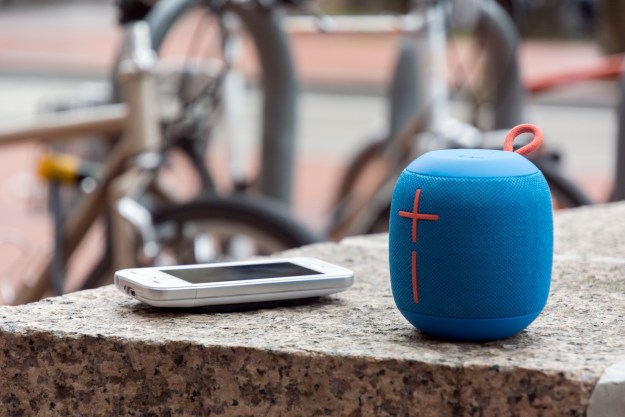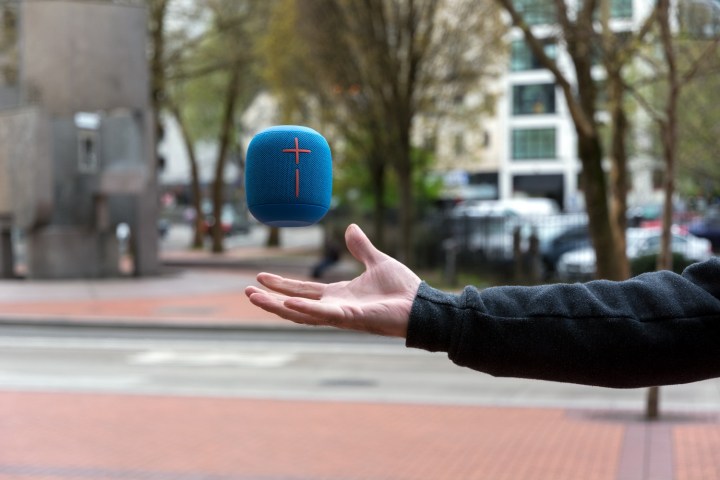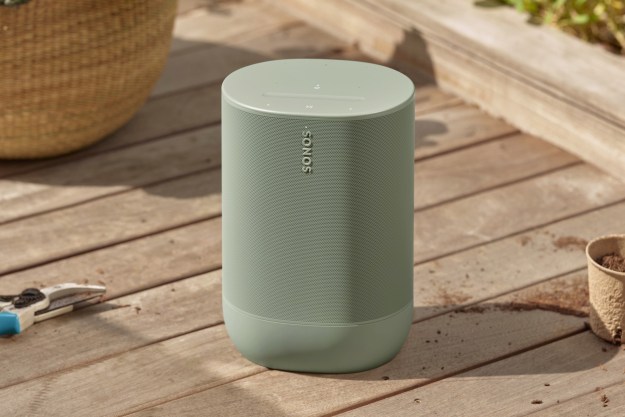
“Rugged, waterproof, and very portable, the Wonderboom is exactly the Bluetooth speaker your summer needs.”
- Good sound for its size
- Super durable design
- It floats
- Unorthodox controls and interface
Finding a Bluetooth speaker for outdoor activities is tough. It’s got to be small enough to be easily portable, but still substantial enough for robust sound — you want to hear your music and have it sound good while enjoying your time outside, after all.
Furthermore, with the outdoors comes certain hazards, so you need the peace of mind that comes with water resistance and even shock resistance. Still, even if a speaker can withstand splashes, knocks, and some mud, even the most hermetic water resistant design won’t prevent a speaker from sinking to the bottom of a lake or pool. Physics can be a pain.
Ultimate Ears’ Wonderboom wants to be the speaker to solve these issues. It joins the line of Ultimate Ears’ other shockproof and waterproof Bluetooth speakers, but it stands in the middle ground between the company’s cheaper, more portable models, and its bigger, louder, more expensive ones. However, instead of simply bridging this gap, the Wonderboom has its own unique features that give the tiny speaker its own identity.
Out of the box
As we’ll discuss, the Wonderboom is a simple speaker, and the packaging reflects this.
Sliding off a cardboard sleeve and opening a clamshell-like box reveals the speaker itself, its bungee loop hooked around a small tab within the box to keep it in place.
The only literature or instructions included is a small safety and care guide, and an easy-to-read diagram on the box’s interior showing how to power on the Wonderboom and connect a smartphone via Bluetooth.
The Wonderboom also ships with a flat USB micro cord for charging, but that’s the totality of any supplemental materials.
Design
The Wonderboom’s design is simple and neat. It’s a squat cylindrical device, with slip-proof rubberized plastic capping the top and bottom, and a hard mesh grille of waterproof fabric around its circumference. A small bungee loop sits at the top, perfect for hanging the speaker from wires, carabiners, and more. For controls, a power button and all-in-one “UE” button sit on the top, and large “+” and “-” buttons emblazon the front of the speaker, controlling volume up and down, respectively.
The Wonderboom floats — no floaties needed.
Inside the 15-ounce Wonderboom are two 40mm drivers supported by two passive radiators, which is how the speaker achieves its so-called 360-degree sound output. The USB micro port is protected by a small tab on the bottom of the speaker, but Ultimate Ears assures that water won’t get gain access to internal electronics, even if this little door is left ajar.
Basically, it looks a lot like other Ultimate Ears speakers, but this time it’s a short cylinder, rather than a tall cylinder like the Megaboom and Boom 2, or tapered puck like the Roll 2.
Durability
The Wonderboom can take a beating that makes it more resilient than most speakers at a similar price point.
Unlike most other UE products, the Wonderboom floats — no floatie accessory needed, as with the Boom 2 and Roll 2. That doesn’t necessarily mean it’s made to be in the water for long periods of time, nor is it designed for playback in water (Bluetooth frequencies have the unfortunate disadvantage of being unable to pass through water. Again, physics can be a pain).
The Wonderboom is rated IPX7 waterproof, so it can be submerged in up to a meter of water for 30 minutes with no issue. Of course, it’s buoyant design makes this an unlikely scenario in the first place. It’s also shock-proof, surviving up to five-foot drops unscathed. This durability makes the Wonderboom a no-brainer for outdoor activities, especially for lounging in the pool or a day on the lake.

We do feel the need to make a couple small exceptions to this, however. While not much heavier than a Roll 2, the Wonderboom is harder to recommend as a backpacking or hiking speaker, simply because its cylindrical shape is bulkier than the disc-shaped Roll 2. Plus, its tiny bungee loop is harder to attach to things than the long strap found on the Roll 2.
Interface
The Wonderboom has a simple, bare-bones control scheme, but that simplicity comes with a learning curve, ironically.
All playback functions are handled through a single button on the top of the speaker; A single tap pauses and plays the current track, while a double tap skips to the next track. This resembles the tap controls of the UE mobile app, minus the app’s visual feedback. The UE button also handles pairing with another Wonderboom — holding down the button for a moment on both speakers simultaneously will pair the two. It’s a simple process and results in expanded sound, or even a quick multiroom setup. You can’t use the two speakers as a stereo pair, however, as you can with two UE Booms or UE Rolls.
Another point of departure from other members of the UE line is that the Wonderboom is not usable with the UE app. This makes for a simpler setup and more straightforward use than other UE speakers, which sometimes require the app for pairing with other devices or for playback. However, you’ll miss out on the benefits that come with this app, like changing EQ settings, or Siri integration on iOS, not to mention a visual interface.
In fact, outside of the basic control scheme, there is no form of user interface on the Wonderboom at all — not even a battery life indicator. Instead, holding down both the volume up and volume down buttons simultaneously will elicit a tone indicating how much juice the Wonderboom’s battery has left. These are easy to understand, with an ascending tone corresponding to high battery, a neutral tone for average battery, and a descending tone for low battery.
The gestalt of these different elements makes for a speaker that’s easy to use once you’ve memorized its various controls and functions. While we can appreciate the aesthetic considerations of having less happening on the speaker itself, we would have preferred more transparency when it came to battery level, or whether a song was paused versus if there was nothing cued up at all.
Performance
So those 40mm drivers? They make for pretty decent sound output for the Wonderboom’s size — 86 dBA, to be exact. In simpler terms, this is about equal to the loudness of a vacuum cleaner or blender. So, pretty loud.
This is where the speaker’s 360-degree design comes in handy. From any angle, whatever you’re listening to will sound like you’re facing the speaker head-on.
This also means the speaker can be audible in situations with lots of background noise. For example, we used the Wonderboom while driving on the highway in a 1993 Subaru that isn’t exactly the quietest drive. Cheaper Bluetooth speakers in the past have failed to produce audible sound within its cab that can compete with the engine, but the Wonderboom was entirely
For outdoor use, the Wonderboom would compete well against the neighbor’s lawnmower or mechanical pool pumps. In quieter, more ideal listening environments, one can better appreciate the Wonderboom’s sound.
One of Ultimate Ears claims with the Wonderboom is that it has better bass than UE’s other outdoor-focused speaker, the Roll 2. From our time testing, we certainly would back up this claim. The Wonderboom’s low end performance is notable given its size. The driving bass of Run the Jewels’ “Talk to Me” was a powerful thrum, and at louder volume had some real impact, while still giving enough room to the rest of the mix; Killer Mike and El-P’s verses came through loud and clear, and the instrumentals were crisp.
The Wonderboom is loud enough to compete well against the neighbor’s lawnmower.
However, push the volume too much and there’s some distortion in the lower register. This was especially apparent when listening to a podcast or spoken word track, as speakers with deeper voices tended to sound boomier than they naturally would. Heavier tracks, like Mastodon’s “Leviathan” were naturally touchier with the volume, too. But we never found any track unlistenable, even at max volume. Given how loud the Wonderboom is anyway, it’s not likely to cause much of an issue.
Distortion at higher volumes aside, we were pleased with the Wonderboom’s sound and performance. It’s loud, the bass is sufficiently robust even outdoors, and its 360-degree output takes any guess work out of where to place it for optimal directionality. It’s a definite step up from UE’s other highly-portable speaker, the Roll 2. However, if the highest quality sound is your goal and you don’t need a smaller speaker, we would suggest dishing out a few more dollars for the more powerful and capable UE Boom 2 instead.
Battery life and Bluetooth range
The Wonderboom is rated for ten hours of battery life at 75 percent volume, but Ultimate Ears often makes conservative battery estimates, and we’re willing to bet it may be better than what they’re touting. We never had an issue with the battery life, even after a weekend of heavy listening, upon which the battery check tone indicated the battery level had dropped to somewhere in the mid-level range.
As for connectivity range, the Wonderboom can maintain connection up to 100 feet. We found the speaker performed well even when the phone we were using for playback was in another room at the other end of the house. This would make having a couple Wonderbooms in separate rooms of a large house during a party feasible. While we don’t claim that two synced Wonderbooms could achieve what a Sonos or PlayFi multiroom setup could, it would be a simple and affordable configuration nonetheless.
Our Take
The Wonderboom’s features and design seem tooled for outdoor use, and with summer approaching, this is important. It’s durable, sounds good, and it floats. At $100, there’s a strong case to be made for Wonderboom as one of the best mini Bluetooth speakers for the price.
Is there a better alternative?
The Wonderboom sits right between other UE products like the Roll 2 and Boom 2 in terms of size, price, and sound. If you need something that’s a bit more portable, the Roll 2 will cover those few instances that the Wonderboom might be too big to bring with. Equally, the Boom 2 is bigger, louder, and its current pricing isn’t that much more than the Wonderboom.
For something outside of the UE family, consider the JBL Flip 4, which offers much more robust bass in an equally waterproof speaker, though it will not float.
How long will it last?
Between its shock resistance, IPX7 water resistance, buoyancy, and strong sound, the Wonderboom is one durable Bluetooth speaker. It’s a great speaker at the $100-level, though it will likely still be in working condition even if you decide to move onto more expensive models in the future.
Should you buy it?
We’re comfortable recommending the Wonderboom. It makes a strong case for being the best speaker for summer-time activities or outdoor functions, especially given its simple controls, setup, and durable construction. Most importantly though, it’s loud and has a decent bass that will handle your favorite tunes well.
Editors' Recommendations
- Best Bluetooth speaker deals: Save on Bose, Sonos, JBL, and more
- The best Bluetooth speakers for 2024: Marshall, Soundcore, JBL, and more
- JBL brings the boom with upgraded portables and party speakers for 2024
- B&O’s latest speaker is a love letter to aluminum
- Anker Soundcore’s Motion X500 packs spatial audio into a more portable package







